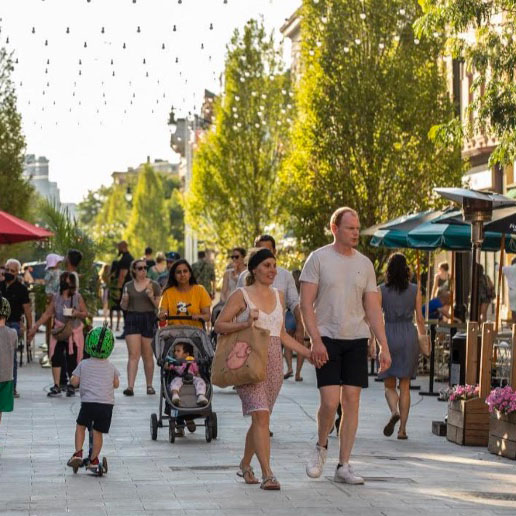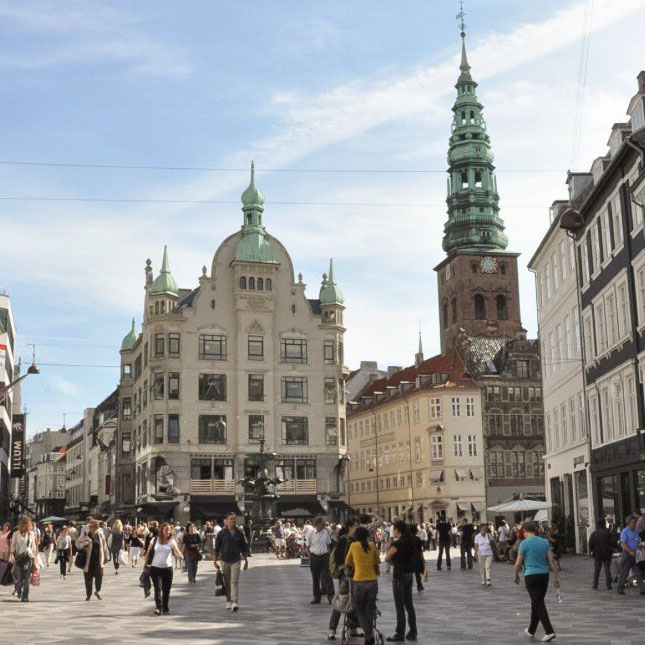Pedestrian streets around the world
-



Pedestrian streets at home
Montreal, Quebec
Following in our own footsteps.
Montreal is already home to several long term, recurring and permanent pedestrian zones. Rue Sainte-Catherine in Quartier des Spectacles, between De Bleury and boulevard Saint-Laurent, is currently being trialed as a long term pedestrian street. De la Gauchetière in Chinatown has been pedestrianized since the mid-1980s, along with Rue Prince-Arthur in the Plateau. For the past few years, Montreal has pedestrianized over 8 kilometers of streets in the summer months, including Avenue Mont-Royal and Rue Wellington. The city has also announced plans to pedestrianise part of Old Montreal over the coming years. Montreal is an active and festive city with lively streets and a culture of dining out. It has a popular transit system, growing cycling culture, and its elected officials have made commitments to reducing the priority of passenger cars.
-



Pearl Street Mall
Boulder, Colorado
A fully pedestrianized street in a city snowier than Montreal.
Named one of America's "Great Public Spaces" by the American Planning Association, the Pearl Street Mall in Boulder, Colorado is a commercial street that hosts a variety of local businesses and restaurants. It was transformed in 1977 as a means to revitalize the historic district threatened by suburban-style shopping centers. The street is filled with public art, including fountains and sculptures as well as a sandbox and play areas for children. During the summer months, the street is a stage for street performers and musicians. Despite the city's extreme winters, with 12% more snow per year than Montreal, Boulder's Pearl Street Mall demonstrates how such spaces are adaptable and feasible no matter the climate.
-



Newark Avenue
Jersey City, New Jersey
Pedestrianisation attracted more people and allowed more businesses to open.
First trialled in 2014, Jersey City closed a block of Newark Avenue to cars on afternoons and weekends. Though it got mixed reviews from business owners and residents of the block, pedestrians and bicyclists were happy, and the city pedestrianized the street in 2015. In 2018, the plaza was expanded to 400 metres in length, and in 2022, a USD$7 million renovation was completed, adding new benches, bike racks, vegetation, trees, and a stage for community events. The city also raised the street with granite pavers for universal accessibility. According to Jersey City's mayor, Steven Fulop: “The creation of the Pedestrian Plaza was a risk our administration took when first elected as there was significant pushback, but I think over time it has become clear to everyone that the changes we made there have attracted more people, allowed more businesses to open, and created a destination spot for visitors and residents.”
-



Strøget
Copenhagen, Denmark
The courage of visionary city leaders allows a cultural hub to flourish.
At over 1km, Strøget is among the longest pedestrian streets in Europe. Part of Copenhagen's several kilometers of pedestrian streets, its transformation in 1962 marked the start of a cultural shift in the way of life for those in the city. Cars were taking over, fewer people were cycling and the city was congested and polluted. At its conception, the idea of a pedestrian street was not generally accepted. The slogan and rallying cry of those opposed was that "Danes are not Italians", as Copenhagen lacked the outdoor social culture seen elsewhere in Europe. People feared the change would be a disaster for the businesses in the street. The town planner, Alfred Wassard, even faced death threats. Visionary political decision-making was needed and the determination of key politicians was vital for this successful transformation of the street and city. The success of the initial pedestrianized section led to the expansion of Strøget's car-free area, which in turn contributed to the transformation of the area into a cultural hub for the city. In the 1990s, they expanded the car-free area once again.
-



Church Street
Burlington, Vermont
A case study in community revitalization.
With a city population density one sixth of Verdun's, Burlington's Church street is a shining example of a small city pedestrian street in a cold climate. It is also an interesting case study in urban redevelopment. Inspired by the changes seen in Copenhagen, Church Street started as a one-day street fair sponsored by the Merchants Association in 1970. City leaders wanted to combat the declining economic vitality of Burlington's downtown area, and create a more vibrant and attractive urban space. After a successful one-day trial, the following year, the street was pedestrianized for a week, with transit added on surrounding streets. The experiment was an obvious success, and after years of dialogue and planning, it was transformed into a permanent pedestrian street. Today, millions of visitors come to socialize, celebrate, pass time, and shop at one of over a hundred shops and restaurants on the street.
-



Sauchiehall, Argyle & Buchanan streets
Glasgow, Scotland
Adapting to a city's changing needs.
Pedestrizanized in the 1970s, this network of streets in downtown Glasgow covers an extensive area of the rainy, northern city. In 1999, Buchanan street was repaved with high quality granite stonework and decorative lighting. Due to changing consumer behaviours, the street's 20 year old shopping mall, Buchanan Galleries, is scheduled to be demolished and replaced with mixed-use buildings, including residences. This allows the city to extend the Sauchiehall pedestrian area to the east of the city, improving connectivity and safety. Proposed options for this new development include the creation of a public park or pavilion that would enable cultural and community events and activities to take place. This change shows how cities can adapt their zoning and commercial activity to add more walkable mixed-use public spaces. These changes support residents, encourage visitors, and increase the vitality of Glasgow's community life.
-



Sparks Street
Ottawa, Ontario
Canada's first pedestrian street.
Sparks Street is a main street of Ottawa. In 1967, it was the first in Canada to be converted to a pedestrian street. The decision to close the street to vehicular traffic was part of a larger initiative aimed at creating a more attractive and vibrant city center. The 850m pedestrian street hosts a number of restaurants, shops, an outdoor market, street performances, art installations, and cultural celebrations, including an ice carving competition as part of the Winterlude annual festival. Sparks Street is also home to several historic, institutional, and office buildings, though their large footprint and presence have been critiqued for impacting life on the street, especially on weekends. As in Montreal's downtown, the addition of residential units is expected to improve the neighbourhood's vitality.
-



State Street
Madison, Wisconsin
A pedestrian street that allows buses.
Though it generally receives less snow compared to Montreal, Wisconsin's capital city of Madison also has cold winters and notable snowfall. Spanning the same length as Wellington at 1.2 kilometres, Madison's State Street was converted into a pedestrian street in 1974. The street is home to a variety of shops, bars, and restaurants. It is popular for its small-town appeal, theaters, art galleries, and music venues. On Halloween, State Street hosts Freakfest, a city-sponsored Halloween festival attended by a costumed crowd of tens of thousands of people. Part of State Street's pedestrian zone has been served by city buses, with service deviated in summer 2023 as part of a trial to maximize space for activities and on-street dining.

